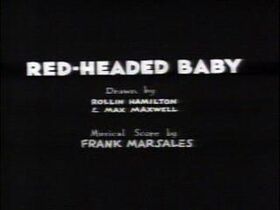|
This article/section is a stub. You can help Looney Tunes Wiki by expanding it. |

|
Deprecated
We have moved to portable infoboxes using the new Template:Shorts
Please do not use this template anymore. It is left here for reference purposes.
| Red-Headed Baby | |||||||||||||||||||||||||||||||||||||||||||||
| |||||||||||||||||||||||||||||||||||||||||||||
|
Red-Headed Baby is a 1931 Merrie Melodies short directed by Rudolf Ising.
Plot
When the toymaker goes to sleep, a red-headed baby doll and the rest of his creations come to life. She turns on the radio and they have a party. An evil spider on the ceiling spies her and comes down to abduct her. Napoleon the toy soldier comes to her rescue.
Availability
- (1992) LaserDisc - The Golden Age of Looney Tunes, Vol. 3, Side 1: Harman-Ising
- (2006) DVD - Cimmaron (1931)
- (2016) DVD - Storks (Wales)
Censorship
- When TBS aired this cartoon (in the days before Cartoon Network and Boomerang were created), they aired a redrawn version that cut the part near the end where the title character dances with two blackfaced dolls.[1]
Notes
- The 1995 dubbed version's opening titles were edited and tweaked because of the opening title card ruined by the hand-color animation.
- This is the first Merrie Melodies short not to feature a recurring character (for example Foxy and Piggy being recurring characters in the Merrie Melodies series), although in a few later Merrie Melodies shorts, they would feature another recurring character, known as Goopy Geer, in the series, though eventually after three shorts featuring the character, they went back to using non-recurring characters throughout the series until the late 1930s and early 1940s.
References



